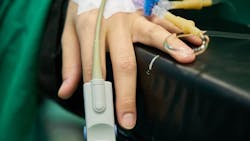Researchers report 21% COVID-19 co-infection rate, Midwest governors form coalition for reopening states
According to the John Hopkins University COVID-19 tracker, the United States has 671,425 cases, including 33,286 deaths. The world case count was 2,172,031 this morning.
A research letter published in JAMA found that rates of COVID-19 co-infections with other respiratory pathogens are 21%, higher than previously thought, suggesting that identification of another pathogen may not rule out the presence of the novel coronavirus.
Also, a letter in the Annals of Internal Medicine detailing survey results on 272 primary care physicians in Lombardy, Italy, who cared for about 400,000 COVID-19 patients found that 40% had symptoms suggestive of the disease, and most had to buy their own personal protective equipment (PPE) and educate themselves on coronavirus management. In the letter, researchers from Humanitas University in Milan, Italy, describe how hospital overcrowding and inadequate PPE and training put healthcare workers—particularly frontline general practitioners (GPs)—at high risk for COVID-19. As of April 8, more than 6,000 Italian medical workers had been infected, and 94 physicians had died, including more than 20 GPs in Lombardy.
Early in the pandemic, reports from China indicated that co-infection of COVID-19 and other respiratory pathogens was uncommon, suggesting that patients who tested positive for other pathogens could be assumed to not have the novel coronavirus.
Also, the US Centers for Disease Control and Prevention recommended testing for other respiratory pathogens, saying that confirmation could help rule out COVID-19 amid the lack of widely available testing.
In the JAMA letter, Stanford University researchers performed real-time reverse transcriptase-polymerase chain reaction for COVID-19 and other respiratory pathogens on nose and throat swabs from 1,206 symptomatic patients from multiple sites in northern California from Mar 3 to 25.
Some sites tested the specimens for COVID-19 as well as influenza A and B, respiratory syncytial virus (RSV), non–COVID-19 coronaviruses, adenovirus, parainfluenza 1 through 4, human metapneumovirus, rhinovirus/enterovirus, Chlamydia pneumoniae, and Mycoplasma pneumoniae.
They found that, of the 116 specimens that tested positive for COVID-19, 24 (20.7%) were positive for at least one other pathogen, versus 294 of the 1,101 specimens (26.7%) negative for the novel coronavirus (difference, 6.0 percentage points [95% confidence interval).
The most common co-infections included rhinovirus/enterovirus (6.9%), RSV (5.2%), and non–COVID-19 coronaviruses (4.3%). None of the differences in rates of non–COVID-19 pathogens between specimens positive and negative for the novel coronavirus was statistically significant.
Of 318 samples positive for at least one pathogen that was not SARS-CoV-2, the virus that causes COVID-19, 24 (7.5%) were also positive for the novel coronavirus. Of 899 samples negative for other pathogens, 92 (10.2%) were positive for SARS-CoV-2 (difference, 2.7 percentage points).
"These results suggest that routine testing for non–SARS-CoV-2 respiratory pathogens during the COVID-19 pandemic is unlikely to provide clinical benefit unless a positive result would change disease management (eg, neuraminidase inhibitors for influenza in appropriate patients)," the authors said.
In other developments:
· President Donald Trump during his daily coronavirus task force briefing announced the first plans for reopening the economy and transitioning from widespread stay-at-home efforts.
· Deborah Birx, MD, White House coordinator of COVID-19 response, said the country had noted declining case counts for 9 days, but still said the physical (social) distancing measured implemented by the White House should be followed through April 30, at a minimum.
· Thursday, another 5.2 million Americans filed for unemployment benefits, raising the total number of Americans to 22 million, or 13% of all US workers, who have lost jobs and income in the wake of the pandemic. According to the US Labor Department, this is the fourth week in a row of catastrophic unemployment numbers.
· Joining governors on the West and East Coasts, seven Midwestern governors announced a new coalition to open the Midwest economic region. In a letter from Michigan Governor Gretchen Whitmer's office, she and the governors of Ohio, Wisconsin, Minnesota, Illinois, Indiana, and Kentucky announced the partnership. “Phasing in sectors of our economy will be the most effective when we work together as a region," the letter said. "The doesn't mean out economy will reopen all at once, or that every state will take the same steps at the same time. But close coordination will ensure we get this right."
· New York Governor Andrew Cuomo said his state and neighboring East Coast states will shutter nonessential businesses through at least May 15. Cuomo said he is working with the governors of New Jersey, Pennsylvania, Rhode Island, Connecticut, Massachusetts, and Delaware to create a safe plan for reopening the economy.
· According to a ProPublica investigation, New York City is recording an average of 200 in-home deaths per day, and Detroit and Boston have also recorded spikes in deaths at home, which may represent undercounted COVID-19 fatalities.
· South Dakota has biggest COVID-19 cluster in the US at the Smithfield pork processing plant in Sioux Falls, South Dakota, is now home to the largest cluster of COVID-19 cases in the country, with 644 people with connections to the plant testing positive. That's more than half of the state's COVID-19 total, which is 1,168. So far, at least one Smithfield plant employee has died from the disease. South Dakota remains one of eight states without statewide shelter-in-place orders.
· In the past week, Nebraska has seen a 30% increase in cases, as has North Dakota. Cases increased by 260% in South Dakota and 26% in Oklahoma. According to Politico, these rates compare to roughly 26% over the same period in New York, the epicenter of the pandemic.
